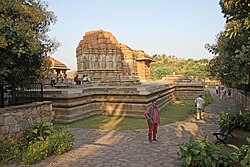Nagda Nag-dah | |
|---|---|
Historical Place | |
 | |
| Country | India |
| State | Rajasthan |
| District | Udaipur District |
| Established | 7th century AD |
| Founded by | King Nagaditya |
Nagda is a village in Udaipur district of Rajasthan state in India. [1] It was once a prominent city in the early Mewar state. Today it is known primarily for the remains of the Sahasra Bahu Temples.


